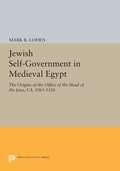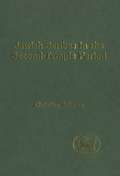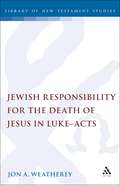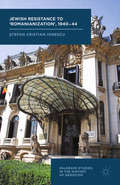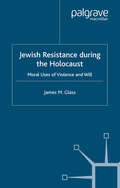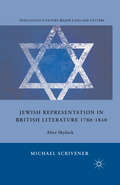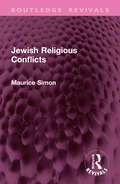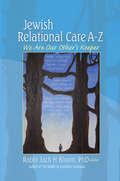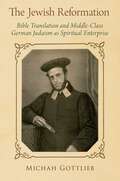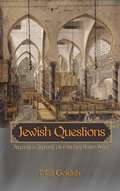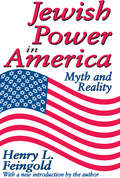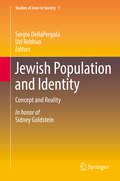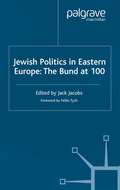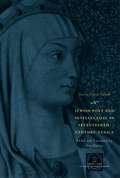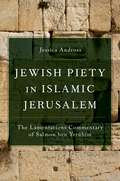- Table View
- List View
Jewish Self-Government in Medieval Egypt: The Origins of the Office of the Head of the Jews, ca. 1065-1126
by Mark R. CohenUnder three successive Islamic dynasties--the Fatimids, the Ayyubids, and the Mamluks--the Egyptian Office of the Head of the Jews (also known as the Nagid) became the most powerful representative of medieval Jewish autonomy in the Islamic world. To determine the origins of this institution, Mark Cohen concentrates on the complex web of internal and external circumstances during the latter part of the eleventh century.Originally published in 1981.The Princeton Legacy Library uses the latest print-on-demand technology to again make available previously out-of-print books from the distinguished backlist of Princeton University Press. These editions preserve the original texts of these important books while presenting them in durable paperback and hardcover editions. The goal of the Princeton Legacy Library is to vastly increase access to the rich scholarly heritage found in the thousands of books published by Princeton University Press since its founding in 1905.
Jewish Scribes in the Second-Temple Period (The Library of Hebrew Bible/Old Testament Studies)
by Christine SchamsJournal for the Study of the Old Testament Supplement series, 291
Jewish Responsibility for the Death of Jesus in Luke-Acts (The Library of New Testament Studies #106)
by Jon WeatherlyFor over a century New Testament scholars have explored the issue of possible antisemitism in Luke-Acts, especially because the author apparently blames the Jews for the death of Jesus. This monograph offers a fresh analysis of this question revealing a different emphasis: that among the Jews only those associated with Jerusalem, especially the Sanhedrin, are responsible for Jesus' death. Luke's Israel is in fact divided in response to Jesus, not monolithically opposed to him. Furthermore, the ascription of responsibility to the people of Jerusalem in Acts, widely regarded as a Lukan creation, in fact is more likely to have been based on sources independent of the synoptics. A consideration of ancient literature concerned with the deaths of innocent victims further suggests a likely "Sitz im Leben" for the transmission of material ascribing responsibility for Jesus' death.
Jewish Resistance to ‘Romanianization’, 1940-44 (Palgrave Studies in the History of Genocide)
by S. IonescuIonescu examines the process of economic Romanianization of Bucharest during the Antonescu regime that targeted the property, jobs, and businesses of local Jews and Roma/Gypsies and their legal resistance strategies to such an unjust policy.
Jewish Resistance During the Holocaust: Moral Uses of Violence and Will
by J. GlassIt is a common belief that Jews did nothing to resist their own fate in the Holocaust. However, the realities of disintegrating physical and psychological conditions, and the efforts of ghetto undergrounds to counter collaborationist judenrat policies and the despair, could not but lead to a breakdown in spiritual life.
Jewish Representation in British Literature 1780-1840: After Shylock (Nineteenth-Century Major Lives and Letters)
by M. ScrivenerDescribing Jewish representation by Jews and Gentiles in the British Romantic era from the Old Bailey courtroom and popular songs to novels, poetry, and political pamphlets, Scrivener integrates popular culture with belletristic writing to explore the wildly varying treatments of stereotypical Jewish figures.
Jewish Religious Conflicts (Routledge Revivals)
by Maurice SimonFirst published in 1950, Jewish Religious Conflicts gives an account of the principal cleavages that have taken place within the Jewish people since the close of the Old Testament over questions of religious faith, doctrine and practice. While passing in review the chief sects that have formed themselves during that period, it pays particular attention to the most recent cleavages, those between the ‘orthodox’ and ‘reform’, and between the ‘conservative’ and ‘liberal’ movements, which are dividing the Jewish community. This book will be of interest to students of religion and history.
Jewish Religious Conflicts (Routledge Revivals)
by Maurice SimonFirst published in 1950, Jewish Religious Conflicts gives an account of the principal cleavages that have taken place within the Jewish people since the close of the Old Testament over questions of religious faith, doctrine and practice. While passing in review the chief sects that have formed themselves during that period, it pays particular attention to the most recent cleavages, those between the ‘orthodox’ and ‘reform’, and between the ‘conservative’ and ‘liberal’ movements, which are dividing the Jewish community. This book will be of interest to students of religion and history.
Jewish Relational Care A-Z: We Are Our Other's Keeper
by Jack H BloomA collection of caregiving tools combining the values of Jewish tradition and self-relations-useful for practitioners of ANY faith!Self-relations, a powerful framework for doing respectful and humane caregiving for oneself and for others is here brought into relationship with Jewish thought. Jewish Relational Care A-Z: We Are Our Other&’s Keeper is an extensive resource for caregiving tools and approaches. Using Jewish tradition and Self-Relations as take-off points, experts from many fields provide insightful perspectives and effective strategies for caregiving.In the language of self-relations each of us is not referred to as a Self. Instead, each of us is more accurately described as a relationship between "selves"-relationship is the basic psychological and religious unit! Jewish Relational Care A-Z: We Are Our Other&’s Keeper sensitively centers on relationships and the healing process, using the understanding that to spark healing in others, a loving, respectful relationship must first be present between every aspect of our "selves." Thirty-six categories of caregiving are comprehensively presented, allowing its use as a helpful resource for any clergy considering any of the included topics. Each author&’s personal reflections, and personal experiences using care tools clearly illustrate how love-respect relationships within oneself can transcend into effective care for others.Jewish Relational Care A-Z: We Are Our Other&’s Keeper provides helpful tools and explores: the use of language as a relational care tool time management for optimum performance for oneself and for others compassion fatigue, the need for self-care, and nurturing your own spiritual and psychological development purposeful visiting as a sacred task silence as an important part of spiritual care the profound difference made in lives through relational listening music as sacred power-a communion between humans and the Divine chanting as an intimate expression of the soul creative ritual in relational healing spontaneous prayer, and its place in relational care relational care with other faiths inside and outside of the community care for those going through divorce care when a pregnancy is unwelcome relational care for sexual orientation and gender identity issues successful caring for those who don&’t care about you dealing with traumatic loss care for those who have sinned sexually fragile relationships care with the healthy aging relational care and retired clergy care for those traumatized by sexual abuse care for the cognitively impaired, mentally ill, and developmentally disabled care for the final moments of life care for the sick and dying care within the grieving processJewish Relational Care A-Z: We Are Our Other&’s Keeper is practical, insightful reading for clergy and caregivers of all denominations, educators, students, and lay people who care about clergy and their work.
Jewish Relational Care A-Z: We Are Our Other's Keeper
by Jack H BloomA collection of caregiving tools combining the values of Jewish tradition and self-relations-useful for practitioners of ANY faith!Self-relations, a powerful framework for doing respectful and humane caregiving for oneself and for others is here brought into relationship with Jewish thought. Jewish Relational Care A-Z: We Are Our Other&’s Keeper is an extensive resource for caregiving tools and approaches. Using Jewish tradition and Self-Relations as take-off points, experts from many fields provide insightful perspectives and effective strategies for caregiving.In the language of self-relations each of us is not referred to as a Self. Instead, each of us is more accurately described as a relationship between "selves"-relationship is the basic psychological and religious unit! Jewish Relational Care A-Z: We Are Our Other&’s Keeper sensitively centers on relationships and the healing process, using the understanding that to spark healing in others, a loving, respectful relationship must first be present between every aspect of our "selves." Thirty-six categories of caregiving are comprehensively presented, allowing its use as a helpful resource for any clergy considering any of the included topics. Each author&’s personal reflections, and personal experiences using care tools clearly illustrate how love-respect relationships within oneself can transcend into effective care for others.Jewish Relational Care A-Z: We Are Our Other&’s Keeper provides helpful tools and explores: the use of language as a relational care tool time management for optimum performance for oneself and for others compassion fatigue, the need for self-care, and nurturing your own spiritual and psychological development purposeful visiting as a sacred task silence as an important part of spiritual care the profound difference made in lives through relational listening music as sacred power-a communion between humans and the Divine chanting as an intimate expression of the soul creative ritual in relational healing spontaneous prayer, and its place in relational care relational care with other faiths inside and outside of the community care for those going through divorce care when a pregnancy is unwelcome relational care for sexual orientation and gender identity issues successful caring for those who don&’t care about you dealing with traumatic loss care for those who have sinned sexually fragile relationships care with the healthy aging relational care and retired clergy care for those traumatized by sexual abuse care for the cognitively impaired, mentally ill, and developmentally disabled care for the final moments of life care for the sick and dying care within the grieving processJewish Relational Care A-Z: We Are Our Other&’s Keeper is practical, insightful reading for clergy and caregivers of all denominations, educators, students, and lay people who care about clergy and their work.
The Jewish Reformation: Bible Translation and Middle-Class German Judaism as Spiritual Enterprise
by Michah GottliebIn the late eighteenth century, German Jews began entering the middle class with remarkable speed. That upward mobility, it has often been said, coincided with Jews' increasing alienation from religion and Jewish nationhood. In fact, Michah Gottlieb argues, this period was one of intense engagement with Jewish texts and traditions. One expression of this was the remarkable turn to Bible translation. In the century and a half beginning with Moses Mendelssohn's pioneering translation and the final one by Martin Buber and Franz Rosenzweig, German Jews produced sixteen different translations of at least the Pentateuch. Exploring Bible translations by Mendelssohn, Leopold Zunz, and Samson Raphael Hirsch, Michah Gottlieb argues that each translator sought a "reformation" of Judaism along bourgeois lines, which involved aligning Judaism with a Protestant concept of religion. Buber and Rosenzweig famously critiqued bourgeois German Judaism as a craven attempt to establish social respectability to facilitate Jews' entry into the middle class through a vapid, domesticated Judaism. But Mendelssohn, Zunz, and Hirsch saw in bourgeois values the best means to serve God and the authentic actualization of Jewish tradition. Through their learned, creative Bible translations, these scholars presented competing visions of middle-class Judaism that affirmed Jewish nationhood while lighting the path to a purposeful, emotionally-rich spiritual life grounded in ethical responsibility.
The Jewish Reformation: Bible Translation and Middle-Class German Judaism as Spiritual Enterprise
by Michah GottliebIn the late eighteenth century, German Jews began entering the middle class with remarkable speed. That upward mobility, it has often been said, coincided with Jews' increasing alienation from religion and Jewish nationhood. In fact, Michah Gottlieb argues, this period was one of intense engagement with Jewish texts and traditions. One expression of this was the remarkable turn to Bible translation. In the century and a half beginning with Moses Mendelssohn's pioneering translation and the final one by Martin Buber and Franz Rosenzweig, German Jews produced sixteen different translations of at least the Pentateuch. Exploring Bible translations by Mendelssohn, Leopold Zunz, and Samson Raphael Hirsch, Michah Gottlieb argues that each translator sought a "reformation" of Judaism along bourgeois lines, which involved aligning Judaism with a Protestant concept of religion. Buber and Rosenzweig famously critiqued bourgeois German Judaism as a craven attempt to establish social respectability to facilitate Jews' entry into the middle class through a vapid, domesticated Judaism. But Mendelssohn, Zunz, and Hirsch saw in bourgeois values the best means to serve God and the authentic actualization of Jewish tradition. Through their learned, creative Bible translations, these scholars presented competing visions of middle-class Judaism that affirmed Jewish nationhood while lighting the path to a purposeful, emotionally-rich spiritual life grounded in ethical responsibility.
Jewish Questions: Responsa on Sephardic Life in the Early Modern Period
by Matt GoldishIn Jewish Questions, Matt Goldish introduces English readers to the history and culture of the Sephardic dispersion through an exploration of forty-three responsa--questions about Jewish law that Jews asked leading rabbis, and the rabbis' responses. The questions along with their rabbinical decisions examine all aspects of Jewish life, including business, family, religious issues, and relations between Jews and non-Jews. Taken together, the responsa constitute an extremely rich source of information about the everyday lives of Sephardic Jews. The book looks at questions asked between 1492--when the Jews were expelled from Spain--and 1750. Originating from all over the Sephardic world, the responsa discuss such diverse topics as the rules of conduct for Ottoman Jewish sea traders, the trials of an ex-husband accused of a robbery, and the rights of a sexually abused wife. Goldish provides a sizeable introduction to the history of the Sephardic diaspora and the nature of responsa literature, as well as a bibliography, historical background for each question, and short biographies of the rabbis involved. Including cases from well-known communities such as Venice, Istanbul, and Saloniki, and lesser-known Jewish enclaves such as Kastoria, Ragusa, and Nablus, Jewish Questions provides a sense of how Sephardic communities were organized, how Jews related to their neighbors, what problems threatened them and their families, and how they understood their relationship to God and the Jewish people.
Jewish Questions: Responsa on Sephardic Life in the Early Modern Period
by Matt GoldishIn Jewish Questions, Matt Goldish introduces English readers to the history and culture of the Sephardic dispersion through an exploration of forty-three responsa--questions about Jewish law that Jews asked leading rabbis, and the rabbis' responses. The questions along with their rabbinical decisions examine all aspects of Jewish life, including business, family, religious issues, and relations between Jews and non-Jews. Taken together, the responsa constitute an extremely rich source of information about the everyday lives of Sephardic Jews. The book looks at questions asked between 1492--when the Jews were expelled from Spain--and 1750. Originating from all over the Sephardic world, the responsa discuss such diverse topics as the rules of conduct for Ottoman Jewish sea traders, the trials of an ex-husband accused of a robbery, and the rights of a sexually abused wife. Goldish provides a sizeable introduction to the history of the Sephardic diaspora and the nature of responsa literature, as well as a bibliography, historical background for each question, and short biographies of the rabbis involved. Including cases from well-known communities such as Venice, Istanbul, and Saloniki, and lesser-known Jewish enclaves such as Kastoria, Ragusa, and Nablus, Jewish Questions provides a sense of how Sephardic communities were organized, how Jews related to their neighbors, what problems threatened them and their families, and how they understood their relationship to God and the Jewish people.
Jewish Preaching in Times of War, 1800 - 2001 (The Littman Library of Jewish Civilization)
by Marc SapersteinWartime sermons reveal how Jews perceive themselves in relation to the majority society and how Jewish and national values are reconciled when the fate of a nation is at stake. They also illustrate how rabbis guide their communities through the challenges of their times. The sermons reproduced here were delivered by American and British rabbis from across the Jewish spectrum—Orthodox to Liberal, Ashkenazi and Sephardi—from the Napoleonic Wars to the attacks of 9/11. Each sermon is prefaced by a comprehensive introduction explaining the context in which it was delivered. Detailed notes explain allusions unfamiliar to a present-day readership and draw comparisons where appropriate to similar passages in contemporary newspapers and other sermons. A general introduction surveys more broadly the distinctive elements of modern Jewish preaching—the new preaching occasions bound up with the history of the countries in which Jews were living; new modes for the dissemination of the sermons (printed pamphlets and the Jewish and general press), and the emergence of women’s voices from the pulpit. It also surveys the distinctive themes of modern Jewish sermons, including responses to Jewish suffering, social justice, eulogies for national leaders, Zionism, and war. What Jewish religious leaders said to their congregations when their countries went to war (or, in some cases, were considering going to war) raises questions of central significance for both modern Jewish history and religious thinking in the civic context. What evidence do these sermons present concerning the degree of patriotism felt by Jews? Where and when do we find examples of dissent from the policies taken by their governments, or explicit criticism? What theological problems are raised by the preachers in the context of unprecedented and unimagined destruction, and how do they respond to these problems? How is the enemy presented in these texts? How is the problem of Jews fighting and killing other Jews addressed? Are the preachers functioning to articulate traditions that challenge the consensus of the moment, or as instruments of social control serving the needs of governments looking for unquestioning support from their citizenry? In all these areas, this book makes an important contribution to the American- and Anglo-Jewish history of this period while also making available a collection of mostly unknown Jewish texts produced at dramatic moments of the past two centuries.
Jewish Power in America: Myth and Reality
by Henry FeingoldJewish political power exists as a separate agency in the American polity, but before it can be determined whether it is inordinate, historian Henry L. Feingold declares that it first needs to be identified and defined. Jewish power is not associated with military armaments as with a sovereign state like Israel. Nor is it personal power. There are many influential Jews today who have raised huge sums for office seekers, but there are none whose use of financial resources was inordinate. With the exception of an abiding concern with the security of Israel, there are no overriding public policy concerns that differentiate Jewish voters from the informed, educated segment of the American electorate.Feingold acknowledges that American Jews do have political power. But what kind is it, and how does it compare to the power exercised by other ethnic and interest groups that thrive in the American polity? The basic charge of those who have raised the alarm about Jewish power—that it is used conspiratorially against the national interest—is addressed and repudiated. This book addresses the question of Jewish power by examining five recent major instances, beginning with the New Deal, when the play of Jewish power, or power exercised by Jews, was evident.The engagement of American Jewry in the political process is amply documented by survey research and evidenced by the disproportionate number of Jewish office holders on all levels of government. It can be traced in some measure to its relationship to European Jewish migration and to the inherent activism of the political left. The work presents the reader with a broadly comprehensive and highly informative picture of American Jewish participation in the American polity.
Jewish Power in America: Myth and Reality
by Henry FeingoldJewish political power exists as a separate agency in the American polity, but before it can be determined whether it is inordinate, historian Henry L. Feingold declares that it first needs to be identified and defined. Jewish power is not associated with military armaments as with a sovereign state like Israel. Nor is it personal power. There are many influential Jews today who have raised huge sums for office seekers, but there are none whose use of financial resources was inordinate. With the exception of an abiding concern with the security of Israel, there are no overriding public policy concerns that differentiate Jewish voters from the informed, educated segment of the American electorate.Feingold acknowledges that American Jews do have political power. But what kind is it, and how does it compare to the power exercised by other ethnic and interest groups that thrive in the American polity? The basic charge of those who have raised the alarm about Jewish power—that it is used conspiratorially against the national interest—is addressed and repudiated. This book addresses the question of Jewish power by examining five recent major instances, beginning with the New Deal, when the play of Jewish power, or power exercised by Jews, was evident.The engagement of American Jewry in the political process is amply documented by survey research and evidenced by the disproportionate number of Jewish office holders on all levels of government. It can be traced in some measure to its relationship to European Jewish migration and to the inherent activism of the political left. The work presents the reader with a broadly comprehensive and highly informative picture of American Jewish participation in the American polity.
Jewish Population and Identity: Concept and Reality (Studies of Jews in Society #1)
by Sergio DellaPergola Uzi RebhunThis book examines the fundamentals of Jewish demography and sociology around the world. It is not only concerned with documenting patterns of population change but also with an intriguing and ever-present issue like "Who is a Jew?" The latter transcends the limits of quantitative assessment and deeply delves into the nature, boundaries, and quality of group identification. A growing challenge is how to bridge between concept – related to ideals and theory – and reality – reflecting field research. Divided into six sections, the book discusses historical demography, immigration and settlement, population dynamics, social stratification and economy, family and Jewish identity in the U.S., and Jewish identity in Israel. The volume represents the dynamic and diverse nature of the study of world and local Jewish populations. It shows how that field of study provides an important contribution to the broader and now rapidly expanding study of religious and ethnic groups. Scholars in disciplines such as history, geography, sociology, economics, political science, and especially demography follow and analyze the social and cultural patterns of Jews in different places around the globe, at various times, and from complementary perspectives. They make use of historical sources that have recently become accessible, utilize new censuses and surveys, and adopt advanced analytical methods. While some of their observations attest to consistency in the Jews’ demographic and identificational patterns, others evolve and ramify in new directions that reflect general processes in the areas and societies that Jews inhabit, internal changes within Jewish communities, and intergenerational trends in personal preferences of religious and ethnic orientations. This volume brings together contributions from scholars around the world and presents new and updated research and insights.
Jewish Politics in Spinoza's Amsterdam (The Littman Library of Jewish Civilization)
by Anne O. AlbertThis book untangles a web of ideas about politics, religion, exile, and community that emerged at a key moment in Jewish history and left a lasting mark on Jewish ideas. In the shadow of their former member Baruch Spinoza’s notoriety, and amid the aftermath of the Sabbatian messianic movement, the Spanish and Portuguese Jews of seventeenth-century Amsterdam underwent a conceptual shift that led them to treat their self-governed diaspora community as a commonwealth. Preoccupied by the question of why and how Jews should rule themselves in the absence of a biblical or messianic sovereign state or king, they forged a creative synthesis of insights from early modern Christian politics and Jewish law and traditions to assess and argue over their formidable communal government. In so doing they shaped a proud new theopolitical self-understanding of their community as analogous to a Christian state.Through readings of rarely studied sermons, commentaries, polemics, administrative records, and architecture, Anne Albert shows that a concentrated period of public Jewish political discourse among the community’s leaders and thinkers led to the formation of a strong image of itself as a totalizing, state-like entity—an image that eventually came to define its portrayal by twentieth-century historians. Her study presents a new perspective on a Jewish population that has long fascinated readers, as well as new evidence of Jewish reactions to Spinoza and Sabbatianism, and analyses the first Jewish reckoning with modern western political concepts.
Jewish Politics in Eastern Europe: The Bund at 100
by J. JacobsA collection of new, scholarly articles on the Jewish Workers' Bund - the first modern Jewish political party in Eastern Europe - written by prominent academics from eight countries. This work represents a broad range of perspectives, Jewish and non-Jewish, sympathetic to the Bund and critical of its work. The articles in this volume are fresh, make use of previously unused source material, and provide us with new perspectives on the significance of the Bund and its ideas.
Jewish Poet and Intellectual in Seventeenth-Century Venice: The Works of Sarra Copia Sulam in Verse and Prose Along with Writings of Her Contemporaries in Her Praise, Condemnation, or Defense (The Other Voice in Early Modern Europe)
by Sarra Copia SulamThe first Jewish woman to leave her mark as a writer and intellectual, Sarra Copia Sulam (1600?–41) was doubly tainted in the eyes of early modern society by her religion and her gender. This remarkable woman, who until now has been relatively neglected by modern scholarship, was a unique figure in Italian cultural life, opening her home, in the Venetian ghetto, to Jews and Christians alike as a literary salon. For this bilingual edition, Don Harrán has collected all of Sulam’s previously scattered writings—letters, sonnets, a Manifesto—into a single volume. Harrán has also assembled all extant correspondence and poetry that was addressed to Sulam, as well as all known contemporary references to her, making them available to Anglophone readers for the first time. Featuring rich biographical and historical notes that place Sulam in her cultural context, this volume will provide readers with insight into the thought and creativity of a woman who dared to express herself in the male-dominated, overwhelmingly Catholic Venice of her time.
Jewish Poet and Intellectual in Seventeenth-Century Venice: The Works of Sarra Copia Sulam in Verse and Prose Along with Writings of Her Contemporaries in Her Praise, Condemnation, or Defense (The Other Voice in Early Modern Europe)
by Sarra Copia SulamThe first Jewish woman to leave her mark as a writer and intellectual, Sarra Copia Sulam (1600?–41) was doubly tainted in the eyes of early modern society by her religion and her gender. This remarkable woman, who until now has been relatively neglected by modern scholarship, was a unique figure in Italian cultural life, opening her home, in the Venetian ghetto, to Jews and Christians alike as a literary salon. For this bilingual edition, Don Harrán has collected all of Sulam’s previously scattered writings—letters, sonnets, a Manifesto—into a single volume. Harrán has also assembled all extant correspondence and poetry that was addressed to Sulam, as well as all known contemporary references to her, making them available to Anglophone readers for the first time. Featuring rich biographical and historical notes that place Sulam in her cultural context, this volume will provide readers with insight into the thought and creativity of a woman who dared to express herself in the male-dominated, overwhelmingly Catholic Venice of her time.
Jewish Poet and Intellectual in Seventeenth-Century Venice: The Works of Sarra Copia Sulam in Verse and Prose Along with Writings of Her Contemporaries in Her Praise, Condemnation, or Defense (The Other Voice in Early Modern Europe)
by Sarra Copia SulamThe first Jewish woman to leave her mark as a writer and intellectual, Sarra Copia Sulam (1600?–41) was doubly tainted in the eyes of early modern society by her religion and her gender. This remarkable woman, who until now has been relatively neglected by modern scholarship, was a unique figure in Italian cultural life, opening her home, in the Venetian ghetto, to Jews and Christians alike as a literary salon. For this bilingual edition, Don Harrán has collected all of Sulam’s previously scattered writings—letters, sonnets, a Manifesto—into a single volume. Harrán has also assembled all extant correspondence and poetry that was addressed to Sulam, as well as all known contemporary references to her, making them available to Anglophone readers for the first time. Featuring rich biographical and historical notes that place Sulam in her cultural context, this volume will provide readers with insight into the thought and creativity of a woman who dared to express herself in the male-dominated, overwhelmingly Catholic Venice of her time.
Jewish Piety in Islamic Jerusalem: The Lamentations Commentary of Salmon ben Yeruhim (AAR Religion in Translation)
by Jessica AndrussThe emergence of the Jewish Bible commentary in the tenth century marks a turning point in Jewish intellectual history, namely, the transition from ancient rabbinic culture to the Arabized Judaism of the medieval period. This book explores a formative moment in this cultural reorientation by analyzing one of the earliest Jewish Bible commentaries. Written in Arabic in tenth-century Jerusalem, Salmon ben Yeruhim's commentary on Lamentations reveals a nuanced negotiation between the rabbinic tradition and the intellectual resources of the Islamic world. Salmon was a prominent figure among the Karaites, a Jewish movement defined by its commitments to biblical scholarship and penitential practices. For him, Lamentations is "instruction for Israel"--spiritual guidance for the Jewish community in exile--and his task is to communicate that instruction. Jewish Piety in Islamic Jerusalem explores the medieval Arabic dimensions of Salmon's project, tracing his engagement with the nascent fields of Arabic literary theory, historiography, and homiletics. The central argument of the book is that Salmon articulates a Jewish pietistic message through emergent Arabic-Islamic genres, transforming them to reflect his own religious and exegetical commitments. In this way, Salmon applies Arabic learning to the Bible at the same time that his understanding of the biblical text expands the Arabic intellectual tradition. The book advances these claims through six analytical chapters and an annotated English translation of the homilies and excursuses of Salmon's commentary.
Jewish Piety in Islamic Jerusalem: The Lamentations Commentary of Salmon ben Yeruhim (AAR Religion in Translation)
by Jessica AndrussThe emergence of the Jewish Bible commentary in the tenth century marks a turning point in Jewish intellectual history, namely, the transition from ancient rabbinic culture to the Arabized Judaism of the medieval period. This book explores a formative moment in this cultural reorientation by analyzing one of the earliest Jewish Bible commentaries. Written in Arabic in tenth-century Jerusalem, Salmon ben Yeruhim's commentary on Lamentations reveals a nuanced negotiation between the rabbinic tradition and the intellectual resources of the Islamic world. Salmon was a prominent figure among the Karaites, a Jewish movement defined by its commitments to biblical scholarship and penitential practices. For him, Lamentations is "instruction for Israel"--spiritual guidance for the Jewish community in exile--and his task is to communicate that instruction. Jewish Piety in Islamic Jerusalem explores the medieval Arabic dimensions of Salmon's project, tracing his engagement with the nascent fields of Arabic literary theory, historiography, and homiletics. The central argument of the book is that Salmon articulates a Jewish pietistic message through emergent Arabic-Islamic genres, transforming them to reflect his own religious and exegetical commitments. In this way, Salmon applies Arabic learning to the Bible at the same time that his understanding of the biblical text expands the Arabic intellectual tradition. The book advances these claims through six analytical chapters and an annotated English translation of the homilies and excursuses of Salmon's commentary.
